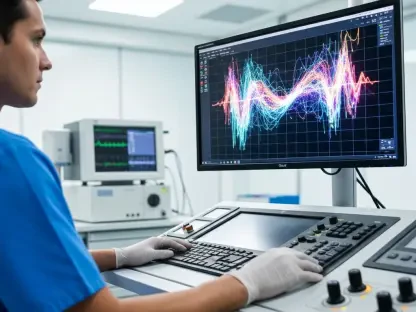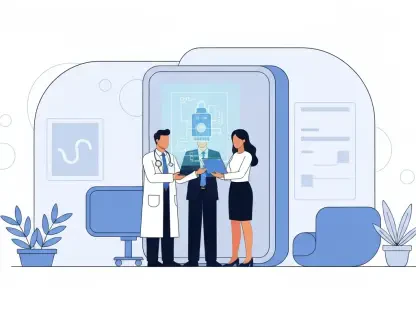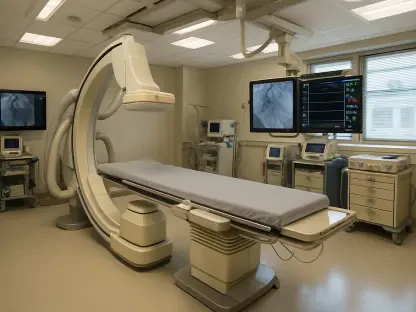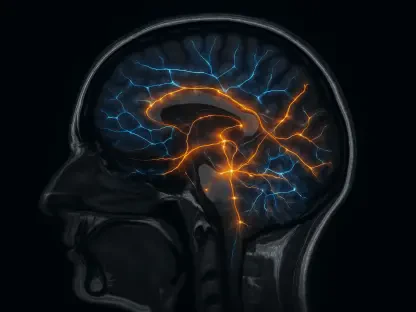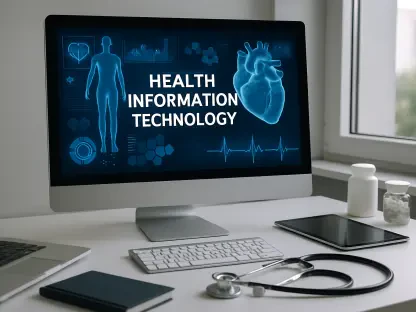The convergence of technology and medicine is driving significant transformations in the healthcare industry, with the Internet of Things (IoT) at the forefront of this change. The IoT in healthcare market is experiencing rapid growth, driven by a proliferation of connected devices that enhance patient care, streamline healthcare operations, and improve medical outcomes. As highlighted in recent analyses and market projections, these advancements are setting the stage for a revolutionary shift in how healthcare is delivered and experienced worldwide.
The Phenomenal Growth Trajectory
Market Value and Projections
The IoT in healthcare market has shown impressive growth over the past decade, valued at US$ 91.71 billion in 2021 and projected to reach US$ 648.94 billion by 2031. This robust growth underscores the immense potential of IoT technologies to effect transformative changes in the healthcare sector globally. With a Compound Annual Growth Rate (CAGR) of 21.8% from 2022 to 2031, the market’s expansion is not merely a trend but a substantial shift towards technologically driven healthcare solutions. The staggering growth projections highlight the increasing reliance on connected devices to enhance medical services and outcomes.
Driving Forces Behind Growth
Several factors contribute to this growth, including technological advancements, increasing adoption of connected devices, and the need for improved healthcare services. The advancement of sensor technologies, greater internet connectivity, and the integration of Artificial Intelligence (AI) are notably pushing the boundaries of what’s possible in healthcare delivery. These innovations allow for more accurate diagnoses, better patient monitoring, and proactive healthcare management. Moreover, the growing complexity of healthcare needs and the demand for personalized medical treatment are driving the adoption of IoT solutions, which offer efficient and scalable ways to meet these needs.
The Power of Connected Healthcare
Integration in Medical Settings
At its core, IoT in healthcare integrates connected devices into various medical settings, including hospitals and clinics. These devices range from simple gadgets like smart thermostats that enhance ambient conditions in medical environments to advanced wearable technologies that monitor and relay health data, significantly enhancing patient comfort, safety, and well-being. By incorporating intelligent devices into everyday healthcare practices, medical professionals can access real-time data that helps in making informed decisions, ultimately leading to better patient outcomes and reduced response times during emergencies.
Real-Time Health Information
The integration of IoT devices empowers patients with real-time health information, enabling more proactive management of their health conditions. For instance, patients with chronic diseases can track vital signs such as blood pressure, glucose levels, and heart rates remotely, providing valuable insights to healthcare providers for timely interventions. This shift towards personalized care is revolutionizing patient care paradigms, fostering a more collaborative approach where patients and doctors can work closely together to manage health conditions. Continuous monitoring can alert both patients and doctors to potential health issues before they become critical, significantly improving overall healthcare quality and patient satisfaction.
Wearable Devices: The Dawn of a New Era
Surge of Wearable Devices
A standout trend within IoT in healthcare is the surge of wearable devices that promise to revamp patient safety and personalized care. Equipped with advanced sensors and connectivity features, these wearable technologies support remote patient monitoring and individualized care. From smartwatches that monitor heart rates to fitness trackers that count steps and analyze sleep patterns, wearable IoT devices are transforming the way health is managed daily. These devices facilitate continuous health monitoring, which is particularly beneficial for patients needing close supervision without the constraints of hospital visits.
Case Study: Manipal Hospitals and Fitbit
Noteworthy is the collaboration between Manipal Hospitals and Fitbit, where Fitbit’s wearable devices, combined with ConnectedLife’s virtual platform, enabled clinicians to remotely oversee patients’ post-surgical recovery by monitoring vital signs. This partnership evolved into a comprehensive remote patient monitoring system, enhancing the recovery process through immediate access to critical health metrics. Such collaborations exemplify how wearable IoT technologies facilitate a holistic, patient-centric approach to healthcare delivery, offering a seamless integration of technology into patient care that extends far beyond the hospital walls.
Government Initiatives Driving Change
Global Efforts for Digital Health Transformation
Several government initiatives worldwide are pushing for digital health transformation by leveraging advanced technologies like IoT, AI, blockchain, and cloud computing. These initiatives aim to democratize healthcare access, improve health outcomes, and reduce costs. Government policies and funding are vital in encouraging the adoption of IoT in healthcare, providing the necessary infrastructure and regulatory frameworks to support innovation. By fostering an environment that encourages the integration of cutting-edge technologies, governments can help bridge gaps in healthcare accessibility and quality, ensuring that all populations benefit from advancements.
Leading Countries in IoT Healthcare
Countries such as India, the U.S., Australia, and Japan are leading these efforts, establishing the foundations for more resilient healthcare infrastructures. For instance, India’s National Digital Health Mission (NDHM) aims to create a unified digital health ecosystem, enhancing efficiency and transparency. In the U.S., the FDA has been actively developing guidelines to ensure safe implementation of IoT in medical devices. These concerted efforts at the national level promote innovation and enhance the accessibility and efficiency of healthcare services, setting benchmarks for other nations to follow.
Regional Dynamics: Asia Pacific Leading the Charge
Pioneering Region in IoT Healthcare Innovation
Asia Pacific stands out as a pioneering region in IoT healthcare innovation. With a burgeoning demand for healthcare services and a solid ecosystem of technology-driven solutions, countries like India, China, and Japan are advancing IoT integration in healthcare. The region’s proactive approach towards adopting new technologies and its significant investments in digital health infrastructure are positioning it as a leader in the global IoT healthcare market. These countries focus on leveraging IoT solutions to address critical healthcare challenges, from managing chronic diseases to providing timely medical assistance in rural areas.
Global Adoption Trends
This trend is not limited to Asia Pacific alone, as regions such as North America, Europe, Latin America, and the Middle East & Africa also actively embrace IoT technologies. Technological advancements, regulatory support, and evolving patient needs drive this global adoption. In North America, the push for IoT is powered by leading tech companies collaborating with healthcare providers to develop innovative solutions. Similarly, Europe’s regulatory frameworks are increasingly accommodating the integration of IoT in healthcare, ensuring patient safety and data security. These global adoption trends highlight the universal appeal and potential of IoT in reshaping healthcare landscapes everywhere.
Key Players in IoT Healthcare
Visionary Companies
The rapid rise of IoT in healthcare is fueled by visionary companies such as Cisco Systems, IBM Corporation, ScienceSoft USA Corporation, and Telit. These companies are dedicated to pushing the boundaries of possibility in the healthcare industry. With a focus on innovation and collaboration, they are expanding the scope of what’s achievable with IoT. Their investments in research and development enable the creation of cutting-edge solutions that address pressing healthcare needs, from improving diagnostic accuracy to enhancing patient engagement and care delivery.
Strategic Collaborations and Innovations
Mergers, acquisitions, and strategic collaborations are prevalent as companies aim to broaden their product portfolios and strengthen their market positions. A consistent focus on research and development by these companies is leading to new frontiers in patient care, unlocking untapped opportunities within the IoT in healthcare sphere. For example, strategic partnerships often facilitate the integration of complementary technologies, resulting in comprehensive healthcare solutions that improve efficiency, reduce costs, and deliver high-quality care. Such collaborations are not only beneficial for the companies involved but also pave the way for groundbreaking advancements in medical practice and patient outcomes.
Conclusion: Embracing the Future
The intersection of technology and medicine is catalyzing considerable changes within the healthcare sector, with the Internet of Things (IoT) leading this evolution. The healthcare IoT market is rapidly expanding due to the surge in connected devices that significantly improve patient care, optimize healthcare operations, and enhance medical outcomes. Recent studies and market forecasts indicate that these technological advancements are paving the way for a revolutionary transformation in healthcare delivery and patient experience on a global scale. From wearable health monitors and smart medical devices to interconnected hospital systems, the IoT is reshaping every facet of healthcare. This convergence promises not only heightened efficiency but also more personalized and predictive patient care, setting a new standard for the future of healthcare. As the IoT continues to grow, it is expected to further transform healthcare, making it more accessible and effective, ultimately benefiting both providers and patients around the world.


